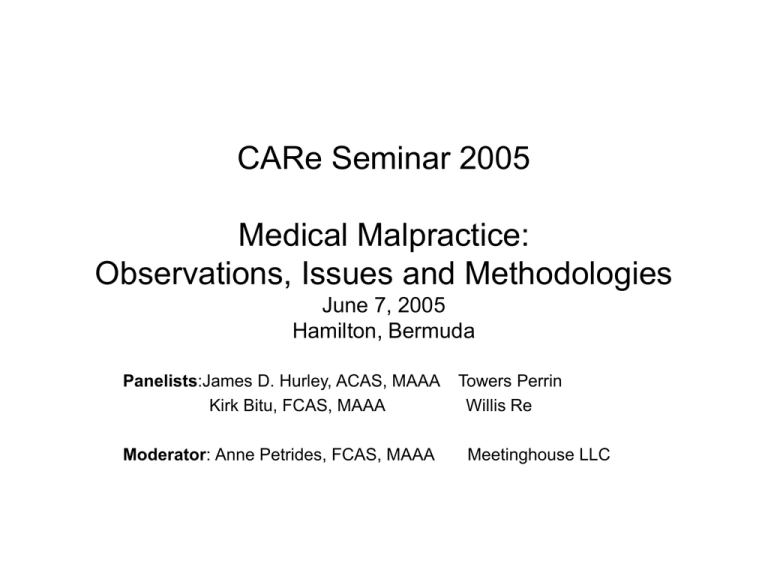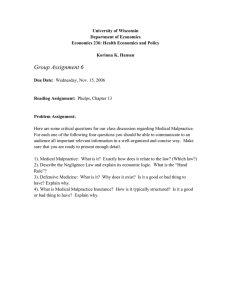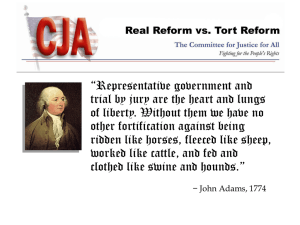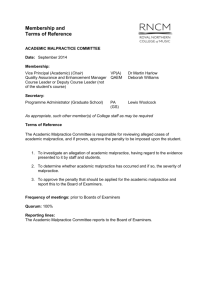CARe Seminar 2005 Medical Malpractice: Observations, Issues and Methodologies June 7, 2005
advertisement

CARe Seminar 2005 Medical Malpractice: Observations, Issues and Methodologies June 7, 2005 Hamilton, Bermuda Panelists:James D. Hurley, ACAS, MAAA Kirk Bitu, FCAS, MAAA Moderator: Anne Petrides, FCAS, MAAA Towers Perrin Willis Re Meetinghouse LLC Session Format • Introductions • Overview and Observations of the current Medical Malpractice Environment including current issues on Tort Reform • Reinsurance Modeling techniques with specific nuances to Medical Malpractice • Discussion with Question and Answer Opportunity Casualty Actuaries in Reinsurance Observations on Medical Malpractice This document is incomplete without the accompanying discussion; it is confidential and intended solely for the information and benefit of the immediate recipient hereof. © 2005 Towers Perrin Observations on Medical Malpractice Financial results Tort reform Insurance reform © 2005 Towers Perrin S:\People\hurlj\Presentations\050607 CARe.ppt Observations on Medical Malpractice Medical Malpractice - Occurrence Direct 180.0 3,500,000 160.0 140.0 2,500,000 120.0 2,000,000 100.0 80.0 1,500,000 Loss Ratio Premiums Earned (millions) 3,000,000 60.0 1,000,000 40.0 500,000 20.0 0.0 0 1995 1996 1997 1998 2000 1999 2001 2002 2003 2004 Year Premiums Earned Loss Ratio Source: Compilation of Best Data © 2005 Towers Perrin S:\People\hurlj\Presentations\050607 CARe.ppt Observations on Medical Malpractice Medical Malpractice - Occurrence Ceded 200.0 800,000 180.0 700,000 140.0 500,000 120.0 100.0 400,000 80.0 300,000 Loss Ratio Premiums Earned (millions) 160.0 600,000 60.0 200,000 40.0 100,000 20.0 0.0 0 1995 1996 1997 1998 2000 1999 2001 2002 2003 2004 Year Premiums Earned Loss Ratio Source: Compilation of Best Data © 2005 Towers Perrin S:\People\hurlj\Presentations\050607 CARe.ppt Observations on Medical Malpractice Medical Malpractice - Occurrence Net 180.0 2,500,000 160.0 140.0 120.0 1,500,000 100.0 80.0 1,000,000 Loss Ratio Premiums Earned (millions) 2,000,000 60.0 40.0 500,000 20.0 0.0 0 1995 1996 1997 1998 2000 1999 2001 2002 2003 2004 Year Premiums Earned Loss Ratio Source: Compilation of Best Data © 2005 Towers Perrin S:\People\hurlj\Presentations\050607 CARe.ppt Observations on Medical Malpractice Medical Malpractice - Occurrence Loss Ratios 200.0 180.0 160.0 140.0 120.0 100.0 80.0 60.0 40.0 20.0 0.0 1995 1996 1997 1998 2001 2000 1999 2002 2003 2004 Year Direct Ceded Net Source: Compilation of Best Data © 2005 Towers Perrin S:\People\hurlj\Presentations\050607 CARe.ppt Observations on Medical Malpractice Medical Malpractice - Claims-Made Direct 160.0 10,000,000 9,000,000 140.0 120.0 7,000,000 100.0 6,000,000 80.0 5,000,000 4,000,000 Loss Ratio Premiums Earned (millions) 8,000,000 60.0 3,000,000 40.0 2,000,000 20.0 1,000,000 0.0 0 1995 1996 1997 1998 2000 1999 2001 2002 2003 2004 Year Premiums Earned Loss Ratio Source: Compilation of Best Data © 2005 Towers Perrin S:\People\hurlj\Presentations\050607 CARe.ppt Observations on Medical Malpractice Medical Malpractice - Claims-Made Ceded 180.0 3,500,000 160.0 140.0 2,500,000 120.0 2,000,000 100.0 1,500,000 80.0 Loss Ratio Premiums Earned (millions) 3,000,000 60.0 1,000,000 40.0 500,000 20.0 0.0 0 1995 1996 1997 1998 2000 1999 2001 2002 2003 2004 Year Premiums Earned Loss Ratio Source: Compilation of Best Data © 2005 Towers Perrin S:\People\hurlj\Presentations\050607 CARe.ppt Observations on Medical Malpractice 7,000,000 160.0 6,000,000 140.0 120.0 5,000,000 100.0 4,000,000 80.0 3,000,000 Loss Ratio Premiums Earned (millions) Medical Malpractice - Claims-Made Net 60.0 2,000,000 40.0 1,000,000 20.0 0.0 0 1995 1996 1997 1998 2000 1999 2001 2002 2003 2004 Year Premiums Earned Loss Ratio Source: Compilation of Best Data © 2005 Towers Perrin S:\People\hurlj\Presentations\050607 CARe.ppt Observations on Medical Malpractice Medical Malpractice - Claims-Made Loss Ratios 180.0 160.0 140.0 120.0 100.0 80.0 60.0 40.0 20.0 0.0 1995 1996 1997 1998 2001 2000 1999 2002 2003 2004 Year Direct Ceded Net Source: Compilation of Best Data © 2005 Towers Perrin S:\People\hurlj\Presentations\050607 CARe.ppt Observations on Medical Malpractice 14,000,000 160.0 12,000,000 140.0 120.0 10,000,000 100.0 8,000,000 80.0 6,000,000 Loss Ratio Premiums Earned (millions) Medical Malpractice - Occurrence & Claims-Made Direct 60.0 4,000,000 40.0 2,000,000 20.0 0.0 0 1995 1996 1997 1998 2000 1999 2001 2002 2003 2004 Year Premiums Earned Loss Ratio Source: Compilation of Best Data © 2005 Towers Perrin S:\People\hurlj\Presentations\050607 CARe.ppt Observations on Medical Malpractice Medical Malpractice - Occurrence & Claims-Made Ceded 200.0 4,000,000 180.0 3,500,000 140.0 2,500,000 120.0 100.0 2,000,000 80.0 1,500,000 Loss Ratio Premiums Earned (millions) 160.0 3,000,000 60.0 1,000,000 40.0 500,000 20.0 0.0 0 1995 1996 1997 1998 2000 1999 2001 2002 2003 2004 Year Premiums Earned Loss Ratio Source: Compilation of Best Data © 2005 Towers Perrin S:\People\hurlj\Presentations\050607 CARe.ppt Observations on Medical Malpractice 9,000,000 160.0 8,000,000 140.0 7,000,000 120.0 6,000,000 100.0 5,000,000 80.0 4,000,000 Loss Ratio Premiums Earned (millions) Medical Malpractice - Occurrence & Claims-Made Net 60.0 3,000,000 40.0 2,000,000 20.0 1,000,000 0.0 0 1995 1996 1997 1998 2000 1999 2001 2002 2003 2004 Year Premiums Earned Loss Ratio Source: Compilation of Best Data © 2005 Towers Perrin S:\People\hurlj\Presentations\050607 CARe.ppt Observations on Medical Malpractice Medical Malpractice - Occurrence & Claims-Made Loss Ratios 200.0 180.0 160.0 140.0 120.0 100.0 80.0 60.0 40.0 20.0 0.0 1995 1996 1997 1998 2001 2000 1999 2002 2003 2004 Year Direct Ceded Net Source: Compilation of Best Data © 2005 Towers Perrin S:\People\hurlj\Presentations\050607 CARe.ppt Observations on Medical Malpractice Financial results impacted by... 1990’s — modest loss trends — favorable reserve development — relatively high investment returns — expansion — slippage in pricing 2000’s — loss trends pick up — unfavorable reserve development — investment returns turn — rates adjusted © 2005 Towers Perrin S:\People\hurlj\Presentations\050607 CARe.ppt Observations on Medical Malpractice 180% 160% 140% 120% 100% 80% 60% 40% 20% Combined Investment Gain 20 02 20 00 19 98 19 96 19 94 19 92 19 90 19 88 19 86 19 84 19 82 19 80 19 78 19 76 0% Operating Source: A.M, Best’s Aggregates and Averages © 2005 Towers Perrin S:\People\hurlj\Presentations\050607 CARe.ppt Observations on Medical Malpractice Frequently discussed tort reforms Caps on non-economic loss Collateral source offsets Limitations on joint-and-several liability Punitive damage restrictions Periodic payments Frivolous suit penalties Limitations on attorneys’ fees Immunity statutes Continued... © 2005 Towers Perrin S:\People\hurlj\Presentations\050607 CARe.ppt Observations on Medical Malpractice Frequently discussed tort reforms (cont’d) Changes in pre-judgment interest Establishment of pre-trial hearing panels Establishment of state-operated funds to handle certain claims Changes to the statute of limitation or statue of repose Mandatory mediation © 2005 Towers Perrin S:\People\hurlj\Presentations\050607 CARe.ppt Observations on Medical Malpractice Tort reform Background – Federal — HR5/HR4280 — MICRA-like Background – State — many have discussed — several have passed — likely impacts – e.g., Texas, Pennsylvania, Florida Continued... © 2005 Towers Perrin S:\People\hurlj\Presentations\050607 CARe.ppt Observations on Medical Malpractice Tort reform (cont’d) Issues/risks — — — — limited data to evaluate prospective credit? interpreted as expected upheld Continued... © 2005 Towers Perrin S:\People\hurlj\Presentations\050607 CARe.ppt Observations on Medical Malpractice Tort reform Issues/risks (cont’d) — specifics – non-economic limit: per defendant or per occurrence – collateral source: jury disclosure or after award – panels: admissible or not – PCF: who defends? – no-fault © 2005 Towers Perrin S:\People\hurlj\Presentations\050607 CARe.ppt Observations on Medical Malpractice Insurance reform For example, Rhode Island proposal — use ‘lowest factor’ of any state — ‘rate formula’ – rate of return formula – number of years for development, trend, ILF’s – specific weights to each experience year — class plan range limited to 500% — use of RBC – surplus exceeds RBC – ‘unreasonably large’ – no rate increase/distribute ‘fairly allocable surplus’ © 2005 Towers Perrin S:\People\hurlj\Presentations\050607 CARe.ppt Observations on Medical Malpractice Are we having fun yet? © 2005 Towers Perrin S:\People\hurlj\Presentations\050607 CARe.ppt W Modeling: Approach CARE Presentation Modeling Technique Typical Modeling exercise for Medical Malpractice Find appropriate option for Med Mal book: – 300,000 Per Occurrence Retention – 500,000 Per Occurrence Retention – 1,000,000 Per Occurrence Retention – ALAE treated pro-rata Reasonable step process: 1. Actuarial analyses: estimate ceded loss by retention 2. Fit loss curve(s) 3. Build model / Simulate loss 4. Report results Specific clash contracts and examples to follow W Modeling Technique Step 1 – Actuarial Analysis: Expected Loss By Layer •Selected loss for each layer •Experience Analysis - trend analysis, loss development analysis - Premium / exposures to current level •Exposure Analysis •Actuarial Judgment Summary of Actuarial Analysis Layer Rentention (A) 0 300,000 500,000 750,000 1,000,000 2,000,000 Limit Experience Rate Exposure Rate Experience Weight Selected Loss in Layer (B) 300,000 200,000 250,000 250,000 1,000,000 1,000,000 (C) 53,142,464 17,564,162 10,440,632 6,097,199 6,942,335 1,200,000 (D) 53,142,464 25,077,247 22,625,780 9,908,166 14,923,142 2,998,391 (E) 100.00% 90.00% 80.00% 70.00% 60.00% 40.00% (F)=(C),(D) wghtd 53,142,464 18,315,470 12,877,662 7,240,489 10,134,658 2,279,035 W Modeling Technique Step 2 – Curve Fitting: Preliminaries Common methods of fitting: – Maximum likelihood estimators – Method of moments – Percentile matching – Sum squared error Inputs needed: – Data points (ultimate loss of the individual claims) Medical Malpractice considerations: – Long-tailed - not all claims in data set are closed – Tort reform / changing social factors create non-homogeneous losses – Clash Losses – Pro-rata ALAE W Modeling Technique Step 2 – Curve Fitting: Addressing Med Mal Considerations Long-tail business: Years with claims not closed? • Common Feedback: – Do not use the ‘green’ years’ fit your curve Tort Reform / Changing Social Factors: Older years have less predictive value • Common Feedback: – Exclude older years in curve fitting / modeling If we use this feedback, we are left with little data to fit to! W Modeling Technique Step 2 – Curve Fitting: Addressing Med Mal Considerations Clash Losses: Modeling clash events • Common Feedback: – Fit a distribution for number of claims per event – Fit a distribution for individual claim severity correlated to claims in event – Find distribution for claimi based on other claims in the event Pro Rata ALAE: Addressing ALAE? • Common Feedback: – Use regression analysis, correlation or fit a copula While the feedback is sound in theory, is it practical or even necessary? W Modeling Technique Step 2 – Curve Fitting: Addressing Med Mal Considerations Statistical complications: – Adjustments for non-homogenous losses, open claims, etc. – Variance-covariance matrix for the clash, in several dimensions – ALAE: copula, regression analysis, correlation • Difficult / impractical to implement • Parameter and model error unavoidable But these issues are implicitly addressed in the actuarial analysis! W Modeling Technique Step 2 – Curve Fitting: Alternative Approach – Using Actuarial Analyses Fit directly to the output of our actuarial analyses Summary of Actuarial Analysis Layer Rentention (A) 0 300,000 500,000 750,000 1,000,000 2,000,000 Limit (B) 300,000 200,000 250,000 250,000 1,000,000 1,000,000 Experience Rate (C) 53,142,464 17,564,162 10,440,632 6,097,199 6,942,335 1,200,000 Exposure Rate (D) 53,142,464 25,077,247 22,625,780 9,908,166 14,923,142 2,998,391 Experience Selected Loss Weight in Layer (E) (F) = wghtd (C),(D) 100.00% 53,142,464 90.00% 18,315,470 80.00% 12,877,662 70.00% 7,240,489 60.00% 10,134,658 40.00% 2,279,035 Fitted Loss* (G) 52,708,144 18,315,478 12,877,666 7,240,491 10,134,660 2,279,036 (G) Loss fit using SSE to Lognormal Selected loss reflects terms of contract: – In this example: Selected Loss and Fitted Loss include ALAE pro rata *In any curve fitting exercise, the analyst will also make necessary statistical considerations. Examples: Non-parametric versus parametric estimators, # of parameter to use, spliced vs. mixed curves vs. incorporating industry curves between nodes, accounting for clusters of points around limits, etc. W Modeling Technique Step 2 – Curve Fitting: Alternative Approach Fitting to data points requires analysis of raw data twice: RAW DATA 1) ACTUARIAL ANALYSIS 2) CURVE FITTING (data points) 3) SIMULATION Alternative approach works from actuarial work already performed: Efficient! RAW DATA 1) ACTUARIAL ANALYSIS 2) CURVE FITTING (actuarial analysis) 3) SIMULATION W Modeling Technique Step 3 – Simulation: Preparing Model Use parameters found in curve fitting to simulate losses Based on varying retentions, model impact on financial statements items • Summary of company underwriting assumptions: Premium 125,000,000 Loss and ALAE 103,989,778 Loss and ALAE Ratio 83.2% U/W Expense Ratio 12.0% W Modeling Technique Step 3 – Simulation: Options Summary of retention options to model Item xs 1M ALAE pro rata xs 500K ALAE pro rata xs 300K ALAE pro rata Retention $1M $500K $250K Selected Loss Cost 9.93% 26.03% 40.68% Reinsurance Rate 12.74% 31.67% 48.91% ALAE coverage Pro rata Pro rata Pro rata W Modeling Technique Step 4 – Report Model Results : Variability in Underwriting Result Gross xs 1M ALAE pro rata xs 500K ALAE pro rata xs 300K ALAE pro rata Average 6,272,638 2,804,298 -829,668 -4,129,742 Standard Dev. 39,471,857 24,560,844 16,394,465 10,812,028 Gross xs 1M ALAE pro rata xs 500K ALAE pro rata xs 300K ALAE pro rata Conf. Level Percentile 1 in 2 50.0% 14,103,742 6,215,023 1,076,202 1 in 10 10.0% (38,916,169) (29,008,083) (22,159,918) (18,207,299) 1 in 100 1.0% (126,861,877) (70,836,225) (48,011,748) (34,413,422) 1 in 250 0.40% (170,471,132) (86,736,496) (57,444,760) (40,179,523) -3,035,565 W Modeling Technique Step 4 – Report Model Results: Variability in Underwriting Result 100,000,000 50,000,000 Probability Results 0 99.6% 75% 50% (50,000,000) 25% .4% ♦ (100,000,000) (150,000,000) (200,000,000) Gross xs 1M xs 500K xs 300K W Avg Modeling Technique Clash: Coverage examples Example 1: Type: Per Occurrence retention Modeling: Per occurrence Example 2: Type: Per Occurrence, Per Risk Cover (same retention) Modeling: Per Occurrence Allocate simulated occurrence losses to per-risk and clash components Example 3: Type: Clash Retention greater than Per Risk Cover Modeling: Per-occurrence model for each per-risk retention Simulate using two curves: Excess Per Risk, Clash Requires correlation–two curves instead of many W Modeling Technique Handling Clash – Allocation of Losses Use actuarial analysis to find per-risk loss in layer AND per-occurrence loss in layer Clash Loss = Per-occurrence minus per-risk OR Model clash separately Summary of Actuarial Analysis Layer Rentention (A) 0 300,000 500,000 750,000 1,000,000 2,000,000 Limit (B) 300,000 200,000 250,000 250,000 1,000,000 1,000,000 Selected Per Occurence Loss (C) 52,708,144 18,315,478 12,877,666 7,240,491 10,134,660 2,279,036 Selected Per Risk Loss (D) 60,096,712 16,234,915 11,505,562 6,834,184 9,131,489 0 Clash Loss (E) = (C) - (D) 2,080,563 3,452,667 3,858,975 4,862,145 7,141,181 Summary of Loss Allocation Layer Rentention (A) 300,000 500,000 750,000 1,000,000 2,000,000 Limit (B) 200,000 250,000 250,000 1,000,000 1,000,000 % of Per Risk Loss (C) 88.6% 89.3% 94.4% 90.1% 0.0% % of Clash Loss (D) 11.4% 10.7% 5.6% 9.9% 100.0% W




